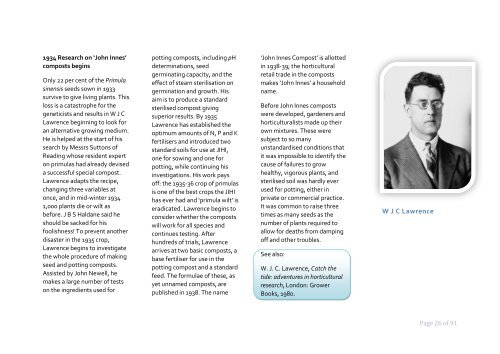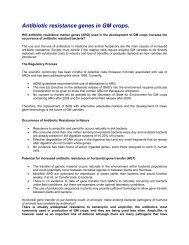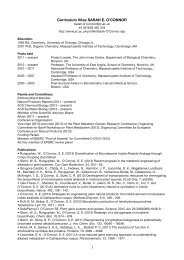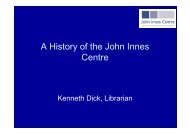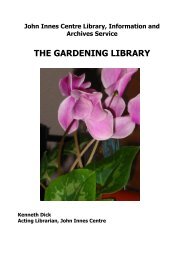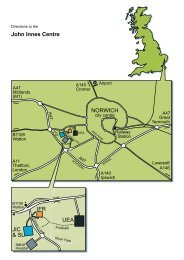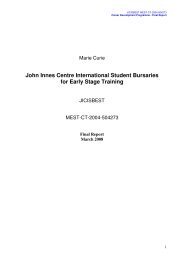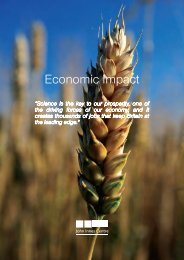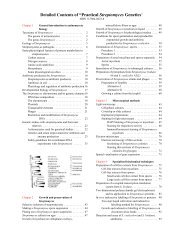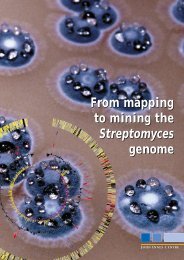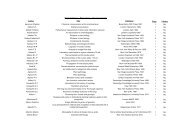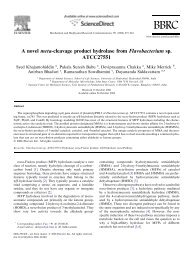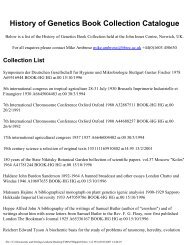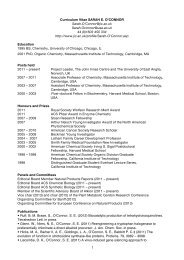1910s Timeline - John Innes Centre
1910s Timeline - John Innes Centre
1910s Timeline - John Innes Centre
You also want an ePaper? Increase the reach of your titles
YUMPU automatically turns print PDFs into web optimized ePapers that Google loves.
1934 Research on ‘<strong>John</strong> <strong>Innes</strong>’<br />
composts begins<br />
Only 22 per cent of the Primula<br />
sinensis seeds sown in 1933<br />
survive to give living plants. This<br />
loss is a catastrophe for the<br />
geneticists and results in W J C<br />
Lawrence beginning to look for<br />
an alternative growing medium.<br />
He is helped at the start of his<br />
search by Messrs Suttons of<br />
Reading whose resident expert<br />
on primulas had already devised<br />
a successful special compost.<br />
Lawrence adapts the recipe,<br />
changing three variables at<br />
once, and in mid-winter 1934<br />
1,000 plants die or wilt as<br />
before. J B S Haldane said he<br />
should be sacked for his<br />
foolishness! To prevent another<br />
disaster in the 1935 crop,<br />
Lawrence begins to investigate<br />
the whole procedure of making<br />
seed and potting composts.<br />
Assisted by <strong>John</strong> Newell, he<br />
makes a large number of tests<br />
on the ingredients used for<br />
potting composts, including pH<br />
determinations, seed<br />
germinating capacity, and the<br />
effect of steam sterilisation on<br />
germination and growth. His<br />
aim is to produce a standard<br />
sterilised compost giving<br />
superior results. By 1935<br />
Lawrence has established the<br />
optimum amounts of N, P and K<br />
fertilisers and introduced two<br />
standard soils for use at JIHI,<br />
one for sowing and one for<br />
potting, while continuing his<br />
investigations. His work pays<br />
off: the 1935-36 crop of primulas<br />
is one of the best crops the JIHI<br />
has ever had and ‘primula wilt’ is<br />
eradicated. Lawrence begins to<br />
consider whether the composts<br />
will work for all species and<br />
continues testing. After<br />
hundreds of trials, Lawrence<br />
arrives at two basic composts, a<br />
base fertiliser for use in the<br />
potting compost and a standard<br />
feed. The formulae of these, as<br />
yet unnamed composts, are<br />
published in 1938. The name<br />
‘<strong>John</strong> <strong>Innes</strong> Compost’ is allotted<br />
in 1938-39; the horticultural<br />
retail trade in the composts<br />
makes ‘<strong>John</strong> <strong>Innes</strong>’ a household<br />
name.<br />
Before <strong>John</strong> <strong>Innes</strong> composts<br />
were developed, gardeners and<br />
horticulturalists made up their<br />
own mixtures. These were<br />
subject to so many<br />
unstandardised conditions that<br />
it was impossible to identify the<br />
cause of failures to grow<br />
healthy, vigorous plants, and<br />
sterilised soil was hardly ever<br />
used for potting, either in<br />
private or commercial practice.<br />
It was common to raise three<br />
times as many seeds as the<br />
number of plants required to<br />
allow for deaths from damping<br />
off and other troubles.<br />
See also:<br />
W. J. C. Lawrence, Catch the<br />
tide: adventures in horticultural<br />
research, London: Grower<br />
Books, 1980.<br />
W J C Lawrence<br />
Page 26 of 91


